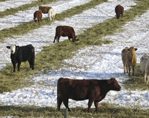Another Look at the Costs and Benefits of Swath Grazing
This article written by Dr. Reynold Bergen, BCRC Science Director, originally appeared in the August 2017 issue of Canadian Cattlemen magazine and is reprinted on the BCRC Blog with permission of the publisher.

Well-managed swath grazing has well-known economic benefits for producers. But research results from a study funded by the Beef Science Cluster showed that it can have environmental benefits as well. Dr. Vern Baron and coworkers at Agriculture and Agri-Food Canada’s Lacombe Research Station recently published Swath grazing triticale and corn compared to barley and a traditional winter feeding method in central Alberta (Canadian Journal of Plant Science 94:1125-1137) and Effect of winter feeding systems on farm greenhouse gas emissions (Agricultural Systems 148:28-37).
What they did:
A five-year winter feeding study was conducted in central Alberta (2008-09 through 2012-13). Angus x Hereford and Red Angus x Charolais cows were fed barley silage, barley grain, barley straw and hay in confinement, or swath-grazed on triticale or corn for 120 days. Confined cows were fed once daily and had a heated waterbowl. Swath grazed cows were restricted to three or four days of feed at a time using electric fences; they also had an all-season waterer, bedding pack and windbreak. Forage quality was monitored weekly (confined feeding) or monthly (swath grazing); protein levels were adequate for all diets, and fiber levels and digestibility were similar. All production costs were calculated and cow weight, body condition score and ultrasound backfat depth were monitored for all five years. Emissions of three greenhouse gases (carbon dioxide from crop production and yardage, methane from rumen digestion and manure, and nitrous oxide from soil and manure) were calculated for the first three years.
What they learned:
Feed production: Growing feed for the confinement-fed control cows was always costlier than raising triticale for swath grazing. Corn was more expensive to grow than triticale, and at least as costly as the feed used in the confined treatment in three out of five years. But because yardage costs were lower for swath grazing than for confined feeding, average total feed costs for triticale ($0.78/cow/day) and corn grazing ($1.05/cow/day) were much lower than for confined feeding ($1.98/cow/day).
Greenhouse gas emissions were 11% lower for the triticale swath grazing and 24% lower for the corn swath grazing compared to the confined feeding treatment. Nitrous oxide emissions from manure were slightly higher for swath grazing than confined feeding. But confined feeding had slightly higher carbon dioxide emissions (from burning diesel to haul feed, process feed, feed cows, and haul manure) and much higher manure methane emissions than the swath grazed treatments. In fact, methane emissions accounted for nearly a quarter of total emissions in the confined treatment, but less than 2% in the swath grazing treatments.
Body weight and condition scores: Over the 120 day winter feeding period, confined cows maintained their body condition and backfat and gained weight. Swath grazed cows lost weight and a small amount of body condition and backfat. At the end of the 120 day wintering feeding period, cows fed in confinement weighed at least 100lbs more than either group of swath grazed cows.
What it means:
We’ve known for a long time that well-managed extended winter grazing programs can considerably reduce daily winter feeding costs. However, the new finding that extended winter grazing generates measurable reductions in greenhouse gas emissions is important, especially considering the emission source. Most of the greenhouse gas emission reductions in swath grazed cattle came from lower manure methane emissions, not from burning less diesel fuel. Using less diesel, time, labor and equipment to clean corrals and spread manure provides a direct benefit to the swath grazing producer. But the fact that manure deposited during swath grazing emits less greenhouse gas than manure in a corral bedding pack really benefits society more than the producer. That’s an ecological good.
The loss in body condition score and weight in the swath grazed cows is equally noteworthy. Swath grazed cattle have higher energy needs because they are more exposed to wind chill and work harder for their feed. These swath-grazed research cattle lost body condition and weight even though they were provided with water, bedding, a windbreak, and cross-fencing to ensure that fresh feed was available every few days. They probably would have lost much more weight, backfat and body condition if they had not had bedding or a windbreak, or if uncontrolled access to the swaths had allowed them to eat the best quality feed first and waste the rest, or if snow had been used as the sole water source. This goes double for heifers and young cows that are still growing. Cows that don’t reach their optimal body weight and condition before the breeding season starts will cycle later, rebreed and calve later (or not at all), and be culled sooner. The economics of mismanaged extended winter grazing may be profoundly unfavorable if females are culled before they have weaned enough calves to pay for themselves.
Click here to subscribe to the BCRC Blog and receive email notifications when new content is posted.
The sharing or reprinting of BCRC Blog articles is typically welcome and encouraged, however this article requires permission of the original publisher.
We welcome your questions, comments and suggestions. Contact us directly or generate public discussion by posting your thoughts below.